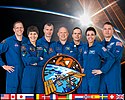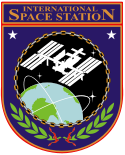Expedition 67
| Expedition 67 | |||
 | |||
| Uppdragsstatistik | |||
|---|---|---|---|
| Rymdstation: | ISS | ||
| Start: | 30 mars 2022, 07:21:03 UTC | ||
| Slut: | 29 september 2022, 07:34 UTC | ||
| Tid: | 183 dag, 12 min | ||
| Rymdpromenad | |||
| Antal rymdpromenader: | 5 st | ||
| Total tid: | 33 tim, 12 min | ||
| Transport | |||
| Uppskjutning: | med | ||
| Uppskjutningsplats: | Kosmodromen i Bajkonur Kennedy Space Center | ||
| Landning: | med | ||
| Landningsplats: | Kazakstan Atlanten | ||
| Kronologi | |||
| |||

Expedition 67 är den 67:e expeditionen till Internationella rymdstationen (ISS). Expeditionen började den 30 mars 2022 då delar av Expedition 66s besättning återvände till jorden med Sojuz MS-19.
Kjell N. Lindgren, Robert Hines, Samantha Cristoforetti och Jessica Watkins anslöt till expeditionen den 27 april 2022.
Expeditionen avslutades den 29 september 2022 då Sojuz MS-21 lämnade rymdstationen.
Besättning
| Position | Första delen (30 mars - 27 april 2022) | Andra delen (27 april - 5 maj 2022) | Tredje delen (5 maj - 21 september 2022) | Fjärde delen (21 - 29 september 2022) |
|---|---|---|---|---|
| Befälhavare | Hans tredje rymdfärd | Hans tredje rymdfärd | ||
| Flygingenjör | Hans tredje rymdfärd | Hans andra rymdfärd | ||
| Flygingenjör | Hans första rymdfärd | |||
| Flygingenjör | Hans första rymdfärd | |||
| Flygingenjör | Hans första rymdfärd | Hans första rymdfärd | ||
| Flygingenjör | Hennes första rymdfärd | Hans första rymdfärd | ||
| Flygingenjör | Hans första rymdfärd | |||
| Flygingenjör | Hans andra rymdfärd | |||
| Flygingenjör | Hans första rymdfärd | |||
| Flygingenjör | Hennes andra rymdfärd | |||
| Flygingenjör | Hennes första rymdfärd | |||
Externa länkar
| |||||||||||||||||||||
Media som används på denna webbplats
Mission insignia for International Space Station (ISS) Expedition 66, designed to resemble US highway route 66
- The official insignia of the Expedition 66 mission aboard the International Space Station.
The official portrait of the seven-member Expedition 67 crew. From left are, Flight Engineers Robert Hines of NASA; Samantha Cristoforetti of ESA (European Space Agency); Denis Matveev of Roscosmos; Commander Oleg Artemyev of Roscosmos; and Flight Engineers Sergey Korsakov of Roscosmos; Jessica Watkins of NASA; and Kjell Lindgren of NASA.
The International Space Station (ISS) Expedition 67 crew includes NASA astronauts Tom Marshburn, Raja Chari, Kayla Baron, Kjell Lindgren, Bob Hines and Jessica Watkins; Roscosmos cosmonauts Oleg Artemyev, Denis Matveev and Sergey Korsakov; and European Space Agency (ESA) astronauts Matthias Maurer and Samantha Cristoforetti.
- The Expedition 67 patch celebrates our on-going international mission to conduct science and research to improve life on Earth and extend our presence in the solar system.
- The International Space Station (ISS) is poised in the foreground to recognize the contributions of the thousands of engineers, scientists, researchers, trainers, fabricators, leaders, and dreamers who have made this miracle of engineering and sustained operations possible.
- Our beautiful home, the planet Earth, serves as a central element of the patch, just as it is central to the ISS’s mission. While we endeavor to unlock the mysteries of the universe, we are also committed to better understanding the Earth and how we can protect it for future generations.
- Three stars shine bright on a field of black, representing the United States, Russia, and Italy, the three countries with crewmembers on this particular expedition. The numerous stars further scattered across the night sky represent the additional countries that comprise the ISS partnership.
- The life-giving rays of the sun represent our crew’s families, whose love and support make this endeavor possible.
The official insignia of the Expedition 68 mission aboard the International Space Station.
- International Space Station Expedition 68 marks the 24th year of operation since the start of its assembly on orbit. Today, the U.S., Russia, Japan, Canada, and the European Space Agency are partnering in the operation of the largest ever orbital outpost managed by humankind.
- Seven sparkling stars in the vastness of space represent crewmembers and experts on the ground operating the space station. Bright sunbeams illuminate the station, a platform for scientific research, Earth and astronomical observation, education, as well as development of new technologies necessary for the exploration beyond low-Earth orbit, on the Moon and Mars.









